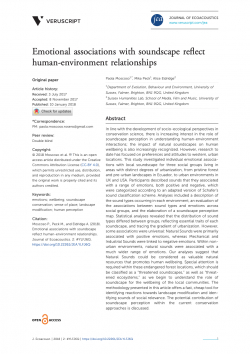Emotional associations with soundscape reflect human-environment relationships

Type
Journal
Category
Article
[ Browse Items ]
Publication Year
2018
Publisher
Journal of Ecoacoustics, United States
URL
[ private ]
Volume
2 (1)
Tags
Abstract
In line with the development of socio-ecological perspectives in conservation science, there is increasing interest in the role of soundscape perception in understanding human-environment interactions; the impact of natural soundscapes on human wellbeing is also increasingly recognized. However, research to date has focused on preferences and attitudes to western, urban locations. This study investigated individual emotional associations with local soundscape for three social groups living in areas with distinct degrees of urbanization, from pristine forest and pre-urban landscapes in Ecuador, to urban environments in UK and USA. Participants described sounds that they associated with a range of emotions, both positive and negative, which were categorized according to an adapted version of Schafer’s sound classification scheme. Analyses included a description of the sound types occurring in each environment, an evaluation of the associations between sound types and emotions across social groups, and the elaboration of a soundscape perception map. Statistical analyses revealed that the distribution of sound types differed between groups, reflecting essential traits of each soundscape, and tracing the gradient of urbanization. However, some associations were universal: Natural Sounds were primarily associated with positive emotions, whereas Mechanical and Industrial Sounds were linked to negative emotions. Within non-urban environments, natural sounds were associated with a much wider range of emotions. Our analyses suggest that Natural Sounds could be considered as valuable natural resources that promotes human wellbeing. Special attention is required within these endangered forest locations, which should be classified as a “threatened soundscapes,” as well as “threatened ecosystems,” as we begin to understand the role of soundscape for the wellbeing of the local communities. The methodology presented in this article offers a fast, cheap tool for identifying reactions towards landscape modification and identifying sounds of social relevance. The potential contribution of soundscape perception within the current conservation approaches is discussed.
Description
https://dx.doi.org/10.22261/jea.ylfj6q
Number of Copies
1
| Library | Accession No | Call No | Copy No | Edition | Location | Availability |
|---|---|---|---|---|---|---|
| Main | 139 | 1 | Yes |